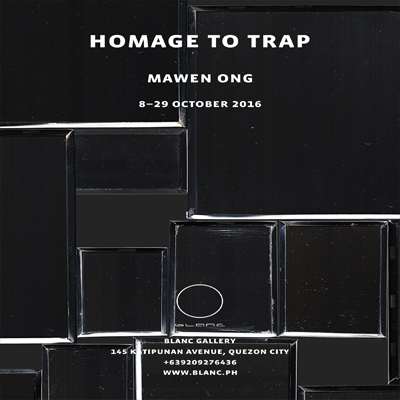
God has Created Nighttime
By Jonathan Olazo
For vanguard practitioner Mawen Ong, “Homage to Trap” is a sweet, perpetrated coup. Utilizing strategies and tools associated with conceptual art, the artist re-engages the art form’s modus operandi in appropriating a group of found objects – an intriguing collection of seventy-five mirrors that consisted a component part of another artist’s installation, thus, allowing the homage.
In continuing to use found objects as a primary way to accomplish a work of art, a consequential subtext is set in play. This allusive content tells on anyone outside the work (a mirror is a recognized symbol of vanity), but traces its way back to addressing the role of the artist in the vital equation that posits the artist vis-à-vis his/her muse – the artwork.
“Homage to Trap” consists of eight large and impressively reproduced photographs that depict seventy-five mirrors that were part of an installation piece created in the 1980s by Roberto Chabet, one of the most influential and highly regarded practitioners of avant-garde thought in Philippine context. In accomplishing each of the photographs, Ong purposefully scanned each of the mirrors and proceeded to make varying arrangements. Her artistry is made apparent in deciding on combinations that go with which in filling up an entire composition. The result is a tantalizing horizon of squares, elegant in their ambiguity, secluding the light but somehow making it more known — it passes through the in-between regions that connect each part.
Touching on the homage aspect of the work, the said sculptural work is entitled “Trap,” and consists of a box that measures 4 x 4 x 4 feet and sits atop a platform that covers an area of 4 x 8 feet. Subtly suggested is a seesaw battle for leverage as the box contends with the implied space beside it at the opposite end of the platform. The insides of the box are lined with mirrors on all of its four sides, and the seventy-five mirrors are arranged in random angles sitting on the floor of the box.
The configuration of mirrors in Chabet’s “Trap” is a marvelous allegory to decipher. The slant angle and position of each mirror is highly suggestive of radio telescopes used to map the night skies in search of life in other planets. Does the allegory portrayed in the work mean: we have tapped a message to the universe, but no one has tapped back? But a practical stance leads to another guess: in this labyrinth of mirrors that reflects back and forth its own image, the standing mirror and the mirror on the box’s sides, where does the image originate? In a sense, this is an allegory about Chabet’s sacred ground of what art should be: it is to make art that depicts only itself – or, it is not necessary for it to reflect anything else, it rids art of its artiness – it is not now the window fabricated that mimics the world, because it has arrived at a place it doesn’t need to.
“Homage to Trap” takes something from this context. Ong extends the idea of making a configuration that traps the reflected image – or a reflection from a source, in this case, a mirror, ceases to be. This cessation is achieved when the mirror is placed facedown atop a flatbed scanner. The scanner absorbs the reflected image – and this image is probably the emitted light from the scanner that moves across to read the object it is scanning. Ultimately, it is the space in-between (mirror and scanner) that is captured in the resulting image.
Yet, “Homage to Trap” continues on the heels of a previous exhibition. Called “Fear of Still Water,”
it stresses on the connotations of mirrors. In one, it is the mythical story of Narcissus who gazed at a pool of water and fell in love with himself. In another it is the postulated observations by Lacan that describes the period in an infant’s upbringing when the child suddenly sees himself in a mirror. It is allowable to deduce there is a degree of anxiety, in its various forms, in both connections. A favorite novelist (Borges) said: “I, who have felt the horror of mirrors. Not only in front of the impenetrable crystal. Where there ends and begins, uninhabitable, an impossible space of reflections”
With regard to the pragmatic focal point that is the flatbed scanner that is thought of as another reincarnation of the camera: What happens when nondescript eyes (mirror and camera) are pitted against each other? Both see nothing and negate the light. But it makes perfect sense. From the same novelist (JLB): “God has created nighttime, which he arms. With dreams, and mirrors, to make clear. To man he is a reflection and a mere, Vanity. Therefore these alarms.”
WORKS
DOCUMENTATION












